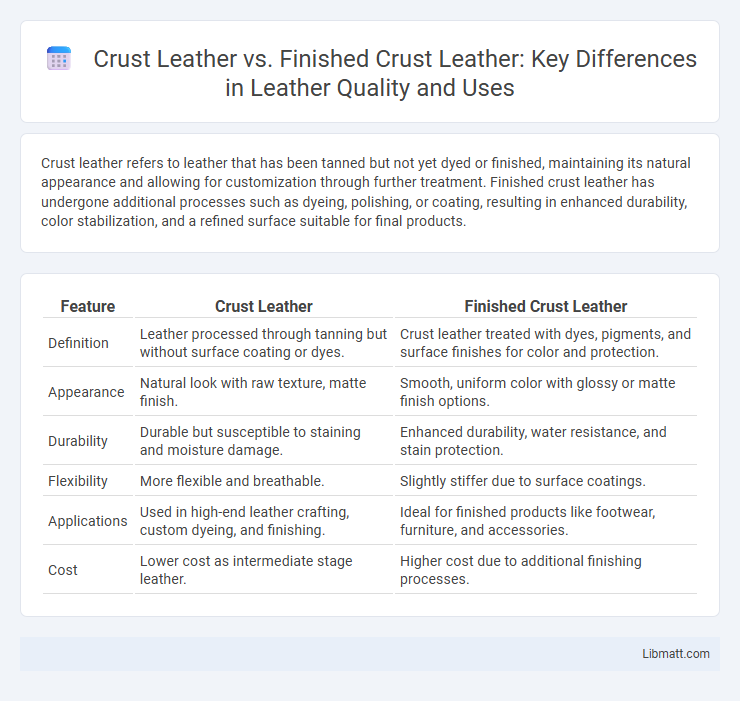Crust leather refers to leather that has been tanned but not yet dyed or finished, maintaining its natural appearance and allowing for customization through further treatment. Finished crust leather has undergone additional processes such as dyeing, polishing, or coating, resulting in enhanced durability, color stabilization, and a refined surface suitable for final products.
Table of Comparison
| Feature | Crust Leather | Finished Crust Leather |
|---|---|---|
| Definition | Leather processed through tanning but without surface coating or dyes. | Crust leather treated with dyes, pigments, and surface finishes for color and protection. |
| Appearance | Natural look with raw texture, matte finish. | Smooth, uniform color with glossy or matte finish options. |
| Durability | Durable but susceptible to staining and moisture damage. | Enhanced durability, water resistance, and stain protection. |
| Flexibility | More flexible and breathable. | Slightly stiffer due to surface coatings. |
| Applications | Used in high-end leather crafting, custom dyeing, and finishing. | Ideal for finished products like footwear, furniture, and accessories. |
| Cost | Lower cost as intermediate stage leather. | Higher cost due to additional finishing processes. |
Introduction to Crust Leather and Finished Crust Leather
Crust leather refers to leather that has undergone tanning but remains uncolored and unfinished, showcasing its natural texture and breathability. Finished crust leather, on the other hand, receives additional treatments such as dyeing, polishing, or coating to enhance appearance and durability. Understanding these differences helps you choose the right leather type for your specific aesthetic and functional needs.
Understanding Crust Leather: Definition and Characteristics
Crust leather is semi-processed animal hide that has been tanned but not yet dyed or finished, retaining its natural texture and color. This stage allows for greater customization in terms of finishing techniques, ensuring your leather products have unique aesthetics and feel. Finished crust leather has undergone additional processes like dyeing, surface coating, and polishing, resulting in enhanced durability and a consistent appearance.
What is Finished Crust Leather? Key Features Explained
Finished crust leather is leather that has undergone further treatment after the initial tanning process to enhance its appearance, durability, and protection. It typically features surface coatings such as pigments, dyes, and sealants that provide a uniform color and texture while improving resistance to moisture, stains, and wear. Your choice between crust leather and finished crust leather depends on whether you prefer a natural, unfinished look or a polished, durable surface suitable for various applications.
Differences Between Crust Leather and Finished Crust Leather
Crust leather is semi-processed leather that has undergone tanning but remains untreated with surface coatings, preserving its natural texture and breathability. Finished crust leather, however, receives additional treatments including dyes, pigments, and protective topcoats to enhance durability, color uniformity, and water resistance. The primary differences lie in appearance, texture, and functionality, with crust leather offering a raw, natural look, while finished crust leather provides a polished, consistent, and more resilient surface suitable for finished goods.
Manufacturing Process: Crust Leather vs Finished Crust Leather
Crust leather undergoes tanning and drying but remains untreated on its surface, allowing natural textures and imperfections to be visible before any finishing. Finished crust leather receives further surface treatments such as dyeing, polishing, or applying protective coatings to enhance durability, appearance, and resistance to wear. Understanding the manufacturing process helps you choose between the raw, malleable qualities of crust leather or the refined, ready-to-use characteristics of finished crust leather.
Durability Comparison: Crust Leather vs Finished Crust Leather
Crust leather offers moderate durability due to its semi-processed state, maintaining natural fibers while lacking surface protection. Finished crust leather provides enhanced durability with added coatings and treatments that improve resistance to moisture, stains, and wear. The finishing process significantly extends the lifespan and performance of crust leather in demanding applications.
Applications and Uses in the Fashion Industry
Crust leather, known for its unfinished, natural surface, is preferred in high-end fashion applications where customization and unique finishes are desired, such as bespoke shoes and artisan handbags. Finished crust leather undergoes dyeing, surface treatments, and protective coatings, making it ideal for ready-to-wear leather jackets, wallets, and accessories that require durability and uniform appearance. Your choice between crust and finished crust leather impacts the final product's texture, color intensity, and long-term wear characteristics in fashion design.
Pros and Cons: Crust Leather
Crust leather offers a natural, untreated surface that allows for greater customization through finishes, providing a unique, rich patina over time and excellent breathability. However, it is more susceptible to stains, moisture, and damage without a protective coating, requiring careful maintenance to preserve its appearance. You benefit from crust leather's ability to develop character but must weigh the extra care needed against the more durable, ready-to-use finished crust leather options.
Pros and Cons: Finished Crust Leather
Finished crust leather features a protective coating that enhances durability, water resistance, and color uniformity, making it ideal for footwear and furniture. However, the added finish reduces breathability and natural aging characteristics, which can detract from the leather's unique patina and flexibility over time. Finished crust leather requires less maintenance but often lacks the authentic feel and aging appeal found in untreated crust leather.
How to Choose Between Crust Leather and Finished Crust Leather
Choosing between crust leather and finished crust leather depends on the desired look and application; crust leather offers a natural, untreated surface ideal for custom finishing, while finished crust leather has a protective coating that enhances durability and color consistency. Consider crust leather for projects requiring personalization and natural aging, whereas finished crust leather suits products demanding immediate wear resistance and uniform appearance. Factors like maintenance needs, texture preference, and end-use functionality are crucial in determining the best option.
Crust leather vs finished crust leather Infographic

 libmatt.com
libmatt.com